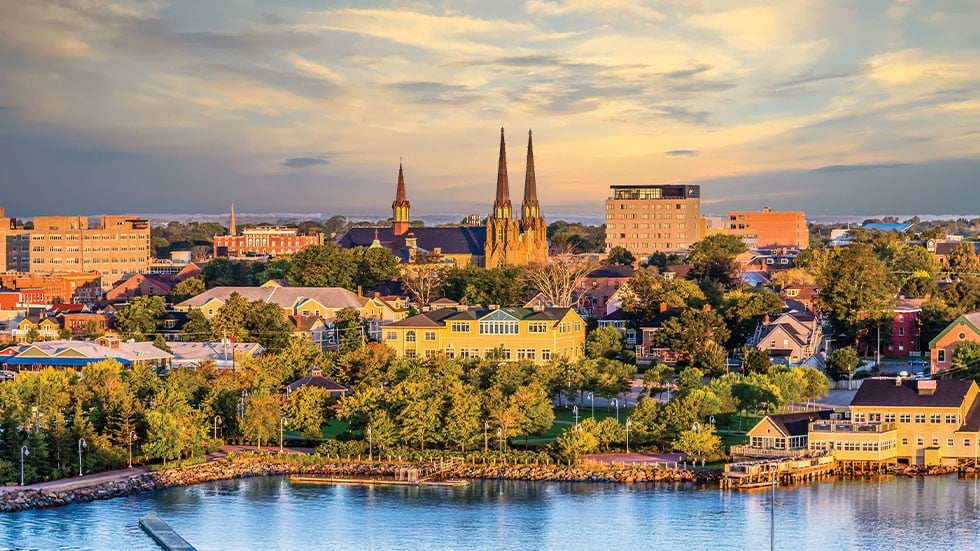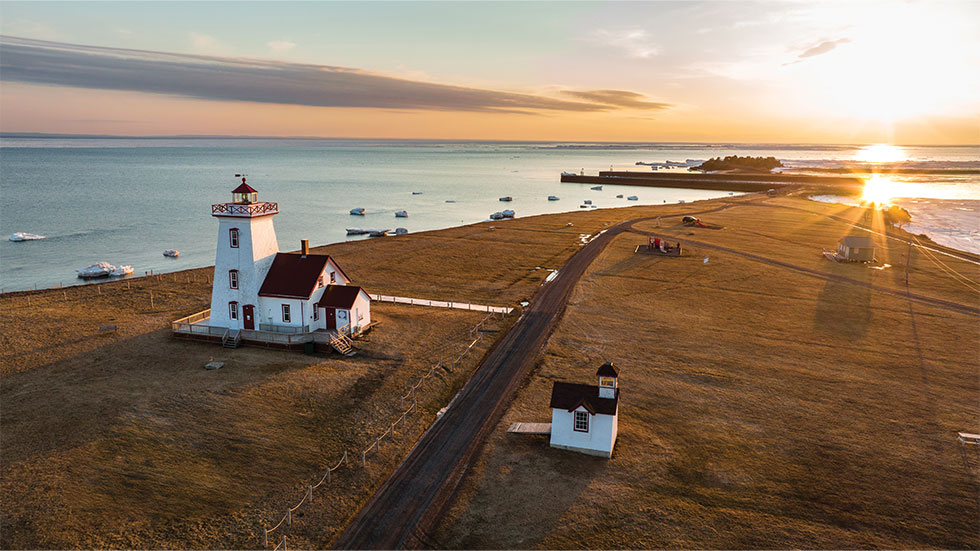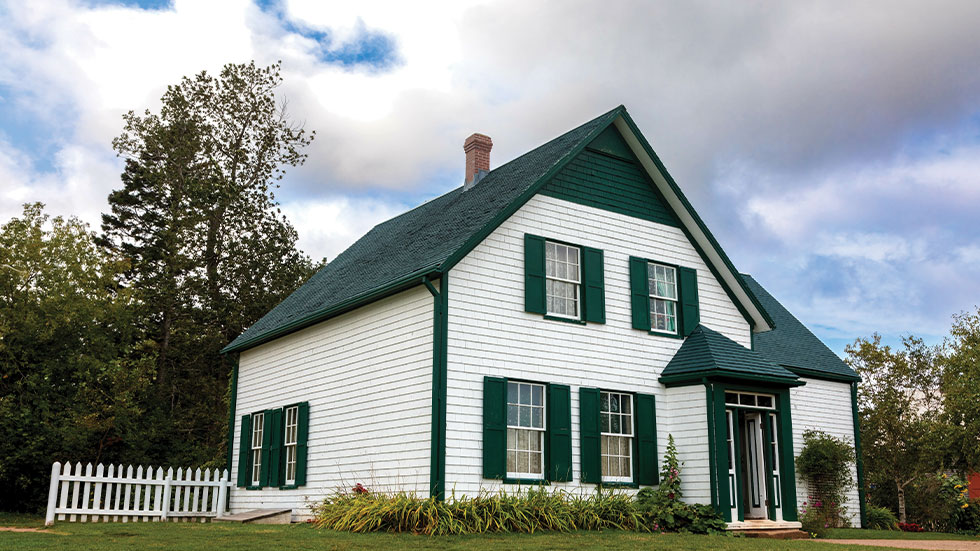The Many Charms of Canada’s Prince Edward Island
This maritime province is home to red sand beaches, lively harbor towns, and the fictional heroine Anne of Green Gables

As a child, I spent nearly as many hours with Anne of Green Gables as I did with friends who didn’t live within the pages of a book. Like the red-headed orphan, I was imaginative, talkative and a budding writer, and I dreamed of one day visiting her “home” (and that of her creator, author Lucy Maud Montgomery) on Prince Edward Island (PEI), a Maritime Province of Canada neighboring Nova Scotia and New Brunswick.
A recent trip to the island proved as marvelous as I’d hoped, even beyond its connections to my favorite fictional heroine. With its pristine beaches, pastoral countryside and charming capital city of Charlottetown, PEI is a tempting destination even for those who aren’t Anne of Green Gables fans.
 Charlottetown, Prince Edward Island, Canada; Photo by dbvirago/Stock.Adobe.com
Charlottetown, Prince Edward Island, Canada; Photo by dbvirago/Stock.Adobe.com
ISLAND CHARMS
I began my long-awaited tour in Charlottetown on the southern shore of the island, which is about 140 miles in length and ranges between 2 and 40 miles wide. After an introduction to the city on a trolley tour, I explored on foot.
Starting at the waterfront, I walked past dockside restaurants, lobster boats and sailboats in the harbor and then took a winding route through the rest of the city. Along the way, I passed Victorian red-brick buildings, gingerbread-trimmed clapboard houses and stately buildings that included St. Dunstan’s Basilica, a French Gothic church with double spires, and the Beaconsfield Historic House, built in 1877 for wealthy shipbuilder and merchant James Peake on a scenic spot overlooking the harbor. At Victoria Park, the city’s largest green space, I strolled along the boardwalk at the water’s edge, savoring the views of the harbor and the sky.
The next day, I set off by car to explore the rolling farmland and lush pastures of the island’s interior. Seeing the patchwork of fields, I understood why PEI is famed not only for its seafood but also for its farm-to-table dining. With an environment ideal for growing potatoes, PEI produces more than 100 varieties that are shipped around the world.
I enjoyed a meal made from locally raised produce—including some of those PEI potatoes—at The Table Culinary Studio, a cozy eatery housed in a former church in the town of New London. Later on my trip, I also sampled more local fare, including a bowl of seafood chowder, at Merchantman Fresh Seafood and Oyster Bar in Charlottetown.
 Historic Wood Islands Lighthouse can be found on a red sand beach on the southeastern shore of PEI; Photo by onurkurtic/iStock.com
Historic Wood Islands Lighthouse can be found on a red sand beach on the southeastern shore of PEI; Photo by onurkurtic/iStock.com
COASTAL APPEAL
As beautiful as the interior of the island is, as soon as I hit the coast again, I could see why it’s considered the crown jewel of PEI. Along the Gulf of St. Lawrence on the island’s south shore, you’ll find red sand beaches and red sandstone cliffs. Bordered by the temperate waters of the Gulf of St. Lawrence, PEI has some of the warmest seawater north of the Carolinas. In Prince Edward Island National Park, which protects 25 miles of beaches, cliffs and grassy bluffs, I watched children play in the waves and saw couples stroll hand in hand.
 The House of Green Gables; Photo by 0Rixie/Stock.Adobe.com
The House of Green Gables; Photo by 0Rixie/Stock.Adobe.com
A NOVEL IDEA
Saving the best for last, I devoted my final day to an Anne of Green Gables literary pilgrimage. I began at the Green Gables Heritage Place in Cavendish for an introduction to All-Things-Anne, including the series’ author. Born on the island in 1874, Montgomery was a schoolteacher and postmistress until she married a Presbyterian minister and moved to Ontario at the age of 37. She published Anne of Green Gables, her first novel, in 1908. The novel’s fictional town of Avonlea was based on Cavendish. Of Montgomery’s subsequent 19 books, all but one were set on PEI. A wall filled with books translated into dozens of languages shows the international popularity of her red-headed heroine.
Next to the visitor center is the eponymous green-gabled house, once the home of Montgomery’s cousins. Wandering through rooms filled with 19th-century furnishings, I felt a sense of déjà vu. It wouldn’t have surprised me to see a breathless Anne burst into the kitchen, eager to talk to the elderly brother and sister who took her in as an orphan.
After leaving the house, I walked to nearby Montgomery Park, where a bronze statue of the author shows her with eyes closed and chin raised in a moment of inspiration. Another short walk brought me to the site where her childhood home once stood (though the house was demolished around 1920, its foundation marks the spot). Today, the park-like area has signs bearing quotations from Montgomery and her works.
After a brief stop at the nearby cemetery where Montgomery is buried, I drove 7 miles to the small home where she was born. On its doorstep, I met a fellow Anne fan, a red-haired woman who had come all the way from Ireland to explore Montgomery’s legacy.
“Thanks to the books and films, people feel like they know Anne,” explained docent Deb Quaile on my guided tour of the home. “She’s a plucky orphan who endured hardships with grace and good humor. Women especially identify with her. When they come here, they feel like they’re reuniting with an old friend.“
That was certainly true for me, I reflected, as I headed to the Anne of Green Gables Museum, which is housed in the place where another set of Montgomery’s cousins once lived and where she and her husband were married in 1911. Nearby is a modest pond that was reimagined as the Lake of Shining Waters in the Anne books.
Finally, it was time to head back to Charlottetown, where I ended my day at a performance of Anne of Green Gables: The Musical, which is presented throughout the summer in alternating years (the next one is scheduled for 2024). After seeing all the sites connected to her life, I was delighted to get the chance to see Anne in the “flesh.”
